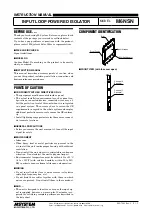
Section 3
1MAC052634-MB D
Vendor-specific implementation
38
615/620 series ANSI
Communication Protocol Manual
3.3.9
Fault records
A fault record is created by the IED as a set of registrations during a detected fault period.
The registration includes the selected peak values and the duration values of the protection
stages, the time of recording, and the sequence number for the fault record.
The size of the IED's internal Modbus fault record buffer is 100 records. The 100 latest
fault records are at any time readable from the IED. The Modbus fault record is Modbus
dependent and the data organization and buffer size differ from the IED's initial system
level registrations. When the Modbus fault record buffer becomes full, the IED overwrites
the oldest records in the buffer.
Multiple clients support
Several Modbus clients can independently of one another read out the Modbus fault
records from the IED. The Modbus fault record buffer keeps track of where in the buffer
the different clients are reading at the moment. Clients are identified either by the serial
port from where the requests are issued or by the client's IP address in the TCP/IP network.
3.3.9.1
Fault record structure
The IED's fault record structure consists of a fixed header part and an application data part.
The application data part is always IED type specific. The whole fault record including the
IED-specific application data part is found in the Modbus memory map section.
4xxxx + 101
Sequence Number 10
Event record 10
4xxxx + 102
Unread records left 10
4xxxx + 103
TimeStamp 10
4xxxx + 104
TimeStamp 10
4xxxx + 105
TimeStamp 10
4xxxx + 106
TimeStamp 10
4xxxx + 107
Event Type 10
4xxxx + 108
Data Object Id 1_10
4xxxx + 109
Data Object Id 2_10
4xxxx + 110
Data Value 10
4xxxx + 111
Data Value 10
1. See Modbus ANSI point list manual for specific event record structure mapping.
Address
1
Register
Values
Description
















































